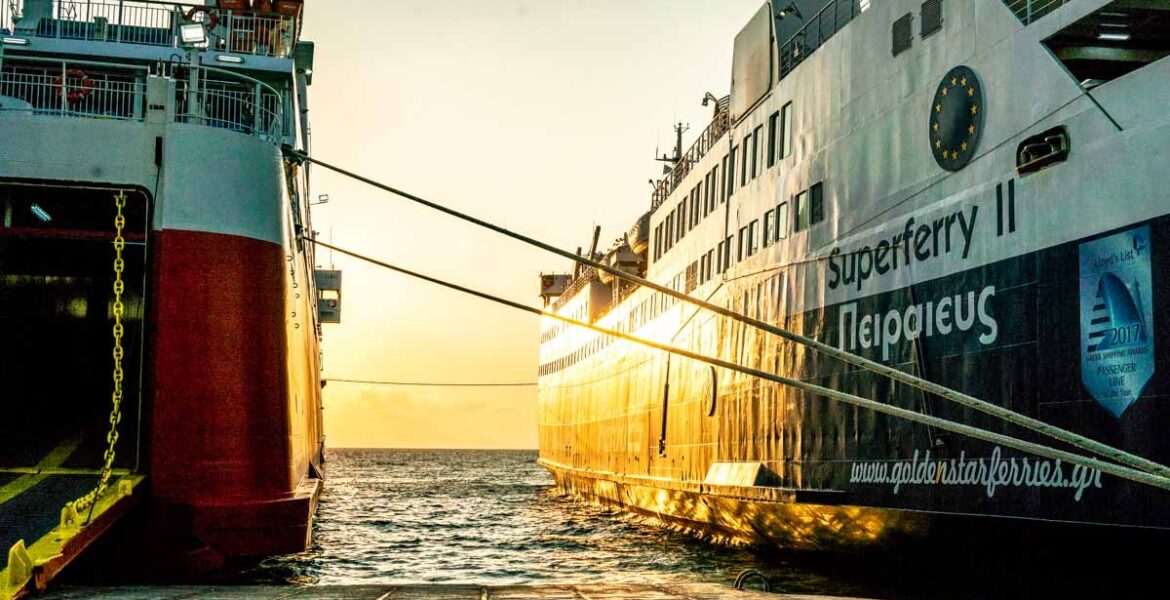Ships will remain docked in the country's ports on Wednesday and Thursday due to a 48-hour strike, the Panhellenic Seamen's Federation (PNO) announced.
In the announcement, they talked about "the reluctance and sterile negative behaviour of the employer side to sign a new collective agreement for 2020 and 2021 with real and substantial increases, but also to staff the ships based on modern and real needs."
One of the most affected ports will be the one in Piraeus.
ABOUT PIRAEUS PORT
The Port of Piraeus is the chief sea port of Athens, Greece, located on the Saronic Gulf on the western coasts of the Aegean Sea, the largest in the Mediterranean and the fourth largest in Europe.
The Port of Piraeus served as the port of Athens since ancient times.
Until the 3rd millennium BC, Piraeus was a rocky island connected to the mainland by a low-lying stretch of land that was flooded with sea water most of the year.
It was then that the area was increasingly silted and flooding ceased, thus permanently connecting Piraeus to Attica and forming its ports, the main port of Cantharus and the two smaller of Zea and Munichia.
In 493 BC, Themistocles initiated the fortifications of Piraeus and later advised the Athenians to take advantage of its natural harbours’ strategic potential.
In 483 BC, the Athenian fleet left the older harbour of Phaleron and it was transferred to Piraeus, distinguishing itself at the battle of Salamis between the Greek city-states and the Persians in 480 BC.
In the following years Themistocles initiated the construction of the port and created the ship sheds (neosoikoi), while the Themistoclean Walls were completed in 471 BC, turning Piraeus into a great military and commercial harbour.
It then served as the permanent navy base for the mighty Athenian fleet.
PRESENT
In 2002 PPA and the Greek government signed a concession agreement. The Greek government leased the port zone lands, buildings and facilities of Piraeus Port to PPA for 40 years.
In 2008 the duration of the concession agreement was modified from 40 to 50 years.
With this modification the lease is ending in 2052. Since the Greek government-debt crisis started in late 2009 the Greek government planned to privatize several state-owned assets.
These assets are believed to be worth around 50 billion euros. One of these assets is the port of Piraeus, which is a major employer in the region.
The Port of Piraeus is majority owned by China COSCO Shipping (the successor of China Ocean Shipping (Group) Company (COSCO)), the 3rd largest container ship company in the world.
In 2003 the port had its IPO, after which it was Majority owned by the Greek State (74.5%), while the rest was held by investors.
In 2009, Greece leased the land of dock 2 and what would become dock 3 (both container berths)[citation needed] to COSCO’s subsidiary COSCO Pacific for 35 years. COSCO paid 100 million Euros each year as part of this arrangement.
“The port’s geographic advantages and the quality services offered by us, have helped deliver rapid progress, in a crisis era” said Fu Chengqiu, managing director of Piraeus Container Terminal in 2012.
With COSCO’s investment, the port had broken their 2006 record of 1.5 million TEUs handled by 2011, with dock 2 (COSCO) handling 1.18 million TEUs and Dock 1 (Greek) handling 500,000 TEUs.
In 2009 the financial crisis had brought the TEU volume down to 450,000 for the whole port.
In 2014 The Hellenic Republic Asset Development Fund (HRADF), the Greek government’s privatization agency, sought to sell a majority stake to finance debt.
In 2016, COSCO bought 51% of the port from the HRADF for 280.5 million Euros.
As per an escrow, COSCO will pay 88 million more Euros for an additional 16% stake by 2021, contingent on COSCO making certain investments in the port, including passenger and cruise expansions, dredging, and expansion of the car terminal.
As of 2020, the Port of Piraeus is majority owned by COSCO with 67% of shares (16% in escrow shares).
The HRADF has 7.14% of shares.[13] The rest (25.86%) is held by non-institutional investors. In October of 2021, the HRADF tranferred the 16% escrow shares to COSCO.
COSCO paid 88 million euros for it, and 11.87 million euros in accrued interest as well as a letter of guarantee of 29 million euros.
In October 2009 Greece leased docks 2 and 3 from PPA to the China Ocean Shipping (Group) Company (in short: COSCO) for a 35-year-period. For its presence at the port COSCO is paying 100 million euros every year.
Terminal 1 is operated by PPA S.A. and has a capacity of nearly 1 million TEUs. Terminal 2’s capacity is 3 million TEUs and is run by Piraeus Container Terminal PCT S.A., a subsidiary of COSCO. In 2013, PCT finished the construction of Terminal 3 with a capacity of roughly 2.7 million TEU.
The total port capacity is 6.7 m TEUs. COSCO’s involvement was accompanied by protest.
According to trade unionists of PPA, the arrival of COSCO led to reductions in salary and social benefits, exclusion of union members and increased pressures on time and performance.
According to an interview in 2012 with Harilaos N. Psaraftis, a professor of maritime transport in Athens, in some cases the salaries of workers were $181,000 a year with overtime. Due to union rules a team of nine people was required to work a gantry crane.
COSCO pays around $23,300 and only requires four people at a crane.
Economic performance of container handling has greatly improved since 2009. Before COSCO took over, the container handling record was at 1.5 million TEUs.
These figures rose to 3.692 million containers in 2017. As a result, revenue and profits soared.
In 2017 the Athens stock exchange listed company (OLP) almost doubled its pre-tax profits from 11 to 21.2 million euros.
READ MORE: More than 700(!) cruise ships are expected to dock in Piraeus port in 2022.


